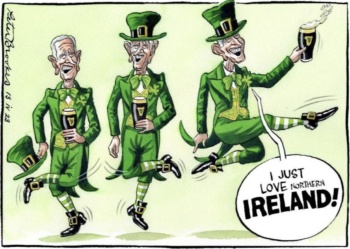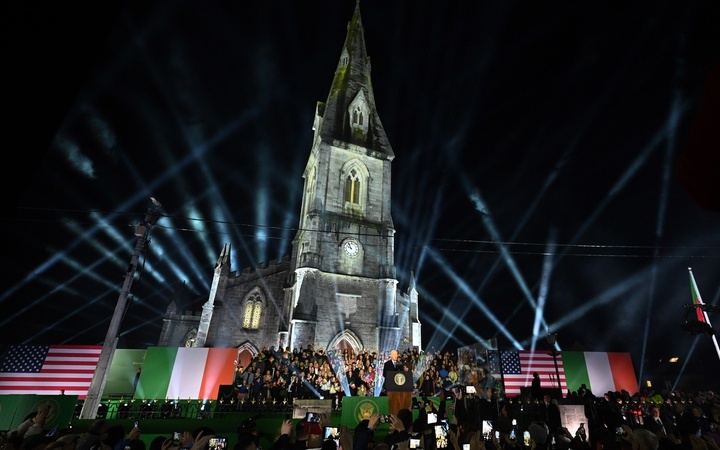Co-published with the Center for Brexit Studies:
The gathering for US President Joe Biden at St. Muredach’s Cathedral in Ballina, County Mayo, Ireland, April 14, 2023 (RTE)
In Belfast, US President Joe Biden commemorated the Good Friday Agreement — the 1998 cross-community deal for a path out of violence in Northern Ireland — and “every day since, the acts of seeing each other through the lens of a common humanity”.
In Dublin, Biden addressed the Irish Oireachtas with invocation of “a present written by our shared responsibility” and “a future poised for unlimited, shared possibilities”.
And before St. Muredach’s Cathedral in his ancestral home of Ballina in County Mayo, he raised hope for “greater liberty, opportunity, and dignity”.
But some commentators in England had no time for a common humanity, shared responsibility, or unlimited possibilities.
Conservative politicans and newspapers bellowed that Biden is not attending the coronation of King Charles III in early May, even though no US President has attended the crowning of the monarch. They chuntered that he had appointed an “avowed Irish republican” — Joe Kennedy, the grandson of the late Sen. Robert Kennedy — as his special envoy to Northern Ireland. They went apoplectic that a Union Jack had not been affixed to the Presidential limousine in Belfast.
Daily Telegraph columnists fumed about an “anti-British President” with “his deeply jaundiced view of Irish history” who “sticks two fingers up at our country”. The Spectator headlined, “Plastic Paddy Joe Biden’s hatred of Britain shames America.” Arlene Foster, the former leader of the Democratic Unionist Party, used the English diatribes to declare that Biden — even though he was visiting Northern Ireland, which is still part of the UK — “hates the United Kingdom“.
The Times let Rod Liddle spew invective about “Joe Biden hopping around Ireland like a senile, gibbering leprechaun with a plastic shamrock sticking out of his nose” — a not-so-subtle racism reinforced by a cartoon by Peter Brookes.

But these expressions of Englishness were not a disconnect with Biden’s America.
To the contrary, they are a revelatory — if dark — post-Brexit connection between the US and Britain. These English commentators are astute and cynical enough to recognize that their country’s self-destructive isolation from Europe but from the post-1945 ties with the former colony. They can contrast that with an Ireland which has become the leading English-speaking country in the European Union — a position giving it an economic and political ascendancy with the Americans.
No wonder Kathy Sheridan of The Irish Times could shrug off the insults in the English press: “As a confident nation, we tend to view this kind of quasi-racist needling as we would a toddler tantrum.”
For after all, the past could step aside for Biden’s “unlimited, shared possibilities”.
The Post-Brexit Reality of the US and Ireland
Of course, Biden’s four-day visit had a personal dimension. Pundits could sniff that his last Irish ancestor had left for the US in 1851. But the President has always been embedded in those distant roots of the Finnegans and the Blewitts. He has invoked their history — thus his appearance in Ballina before the cathedral built with bricks provided by his great-great-great grandfather — and their values: “Every time I’d walk out of [my grandfather’s house in Scranton, Pennsylvania], he’d look at me and say, ‘Joey, remember, the best drop of blood in you is Irish.”
That Irishness is tied to Biden’s sense of political legacy and of his immediate political future. John F. Kennedy, the first US President to visit Ireland in 1963, was also America’s first Irish Catholic resident of the White House. On the 60th anniversary, the second Irish Catholic President was making the journey. Even if most Americans were unaware of the connection, they would have seen the images, just weeks before Biden officially declares his candidacy for re-election: images of a US and its President celebrated, rather than derided, for interventions abroad in the name of peace and security.
But Biden’s tour also had an important tactical and strategic importance. Before the trans-Atlantic flight, he made it clear to reporters, “Make sure the Irish accords and Windsor agreements [for Brexit’s Northern Ireland Protocol] stay in place. Keep the peace and that’s the main thing.”
For years, Biden and other senior US politicians had bluntly warned the UK Government: if the security of Northern Ireland and the Republic are not safeguarded in Brexit, there will be no US-UK trade agreement. House Speaker Nancy Pelosi laid down the line in her April 2019 speech to the Irish Dáil and then in London against “any weakening of the Good Friday accords”: “Don’t even think about it.”
Pelosi — joined on another tour of Ireland by colleagues such as House Foreign Affairs Committee chair Eliot Engel and House Ways and Means chair Richard Neal — repeated in September 2020, “The Good Friday Agreement is the bedrock of peace in Northern Ireland.”
A Brexit Message from Nancy Pelosi and Irish-US Diplomacy
US Democrats Repeat: No Secure Irish Border = No US-UK Trade Deal
Antony Blinken, Joe Biden’s foreign policy advisor and future Secretary of State, tweeted to the same effect. Presidential candidate Biden drove home the point:
We can’t allow the Good Friday Agreement that brought peace to Northern Ireland to become a casualty of Brexit.
Any trade deal between the U.S. and U.K. must be contingent upon respect for the Agreement and preventing the return of a hard border. Period. https://t.co/Ecu9jPrcHL
— Joe Biden (@JoeBiden) September 16, 2020
The UK Government under Prime Minister Boris Johnson defied the warnings. It pressed ahead with the Internal Market Bill to set aside the provisions of the Northern Ireland Protocol, admitting that it was breaking international law in a “specific and limited way”.
And even after Johnson’s ignominious fall from power last year, the cabal of hard Brexiteers, Johnson supporters, and discredited commentators such as former Brexit negotiator David Frost persisted with the threat. The DUP’s withdrawal from the Northern Ireland Assembly was accompanied by the English demand: scrap the customs line down the Irish Sea, scrap any role for the European Court of Justice, or we’ll scrap the Protocol and the arrangements avoiding a hard Irish border.
Johnson’s successor Rishi Sunak finally worked up the political nerve to keep the Protocol in place, joining European Commission President Ursula von der Leyen to announce the “Windsor Framework”.
But the arsonist who puts away the matches doesn’t become the hero, particularly when he’s already taken a sledgehammer to the walls of the house. Inevitably, visitors will look for a more attractive place in the neighborhood.
Barack Obama said in April 2016, standing along Prime Minister David Cameron in London, of a Yes vote in the Brexit referendum two months later: “The UK is going to be in the back of the queue.” But his matter-of-fact assessment was trashed by Brexiteers as Project Fear rather than Project Reality.
That reality — in Biden’s beaming smile and in the well-wishers from Queen’s University Belfast to the Oireachtas in Dublin to St. Muredach’s Cathedral in Ballina — came hard at the English this month. So the reactions of frustration, anger, insult, and racism poured out, all coming from a starting point of recognition and anguish: a recognition that there is no short-term path back for England and an anguish that others, such as Ireland, will benefit.
Put bluntly, is the US looking to invest in a 27-member bloc in which Ireland had a 12.2% increase in GDP last year and is forecast to grow 4.5% this year? Or is its priority a Great Britain which was stagnant in 2022 and is forecast to contract in 2023?
No wonder Joe Biden chose to frame his “shared possibilties” — from his domestic future to his global vision to the US-Ireland relationship — with this invocation: “You know, I often say: We Irish are the only people in the world who are nostalgic for the future.”

